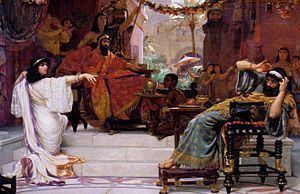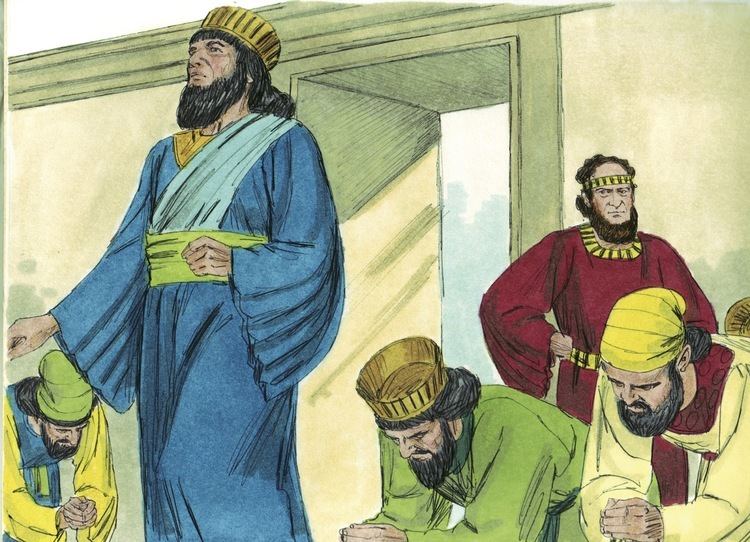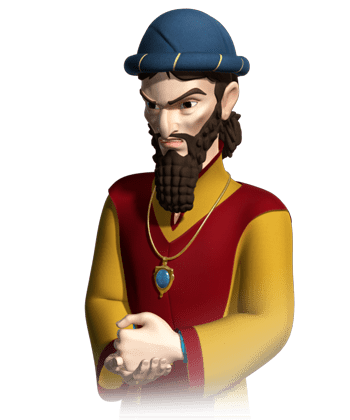Monarch Xerxes I | Spouse(s) Zeresh | |
Died c. 475 BCEAchaemenid Empire Children ParshandathaDalphonAspathaPorathaAdaliaAridathaParmashtaArisaiAridaiVaizatha Similar Mordecai, Esther, Xerxes I, Amalek, Rembrandt | ||
Haman (also known as Haman the Agagite המן האגגי, or Haman the evil המן הרשע) is the main antagonist in the Book of Esther, who, according to the Hebrew Bible, was a vizier in the Persian empire under King Ahasuerus, traditionally identified as Xerxes I. As his name indicates, Haman was a descendant of Agag, the king of the Amalekites, a people who were wiped out in certain areas by King Saul and David.
Contents
- Haman in the Hebrew Bible
- Purim traditions
- Etymology and meaning of the name
- In popular culture
- References

Haman in the Hebrew Bible

Haman is described as the son of Hammedatha the Agagite. In the story, Haman instigates a plot to kill all of the Jews of ancient Persia. Haman attempts to convince Ahasuerus to order the killing of Mordecai and all the Jews of the lands he ruled. The plot is foiled by Queen Esther, the king's recent wife, who is herself a Jew. Haman is hanged from the gallows that had originally been built, on the advice of his wife Zeresh, to hang Mordecai. The dead bodies of his ten sons Parshandatha, Dalphon, Aspatha, Poratha, Adalia, Aridatha, Parmashta, Arisai, Aridai and Vaizatha (or Vajezatha), are also hanged after they die in battle trying to kill the Jews (Esther 9:5-14). Haman is upset that Mordecai refuses to bow down to him, as told in chapter 3:

. . . and advanced him, and set his seat above all the princes who were with him. And all the king's servants, who were in the king's gate, bowed, and did obeisance to Haman; for the king had so commanded concerning him. But Mordecai did not bow, or do him obeisance. (Esther, 3:1-2)

And when Haman saw that Mordecai did not bow or do him obedience, then Haman was full of wrath. But he disdained to lay hands on Mordecai alone; for they had told him of the people of Mordecai; so that Haman sought to destroy all the Jews who were throughout the whole kingdom of Ahasuerus, the people of Mordecai. (Esther, 3:5-6)
Queen Esther, learning that her people are in danger, risks her own life to spare the Jews living in Ancient Persia.
King Ahasuerus asked Queen Esther, "Who is he? Where is the man who has dared to do such a thing?" 6 Esther said, "The adversary and enemy is this vile Haman." Then Haman was terrified before the king and queen. 7 The king got up in a rage, left his wine and went out into the palace garden. But Haman, realizing that the king had already decided his fate, stayed behind to beg Queen Esther for his life. 8 Just as the king returned from the palace garden to the banquet hall, Haman was falling on the couch where Esther was reclining. The king exclaimed, "Will he even molest the queen while she is with me in the house?" 9 As soon as the word left the king's mouth, they covered Haman's face.
9 Then Harbona, one of the eunuchs attending the king, said, "A gallows 50 feet [b] high stands by Haman's house. He had it made for Mordecai, who spoke up to help the king." 10 The king said, "Hang him on it!" 10 So they hanged Haman on the gallows he had prepared for Mordecai. Then the king's fury subsided. (Esther, 7:6-10)
or
9 Then Harbona, one of the king's eunuchs, said, "Haman has set up a sharpened pole that stands seventy-five feet tall in his own courtyard. He intended to use it to impale Mordecai, the man who saved the king from assassination." "Then impale Haman on it!" the king ordered. 10 So they impaled Haman on the pole he had set up for Mordecai, and the king's anger subsided.
Purim traditions
The Jewish holiday of Purim commemorates the story of the deliverance of the Jews and the defeat of Haman. On that day, the Book of Esther is read publicly and much noise and tumult is raised at every mention of Haman′s name. A special noisemaker called in Hebrew a ra'ashan (רעשן) (in Yiddish: "gregger" or "hamandreyir") is used to express disdain for Haman. Pastry known as Oznei Haman (אזני המן, lit. Ears of Haman) (in Yiddish; Hamentashen) are traditionally eaten on this day.
Etymology and meaning of the name
The name has been equated with the Persian name Omanes recorded by Greek historians. Several etymologies have been proposed for it: It has been associated with the Persian word Hamayun meaning "illustrious". (naming dictionaries typically list it as meaning "magnificent"), or with the sacred drink Haoma. or with the Persian name Vohuman meaning "good thoughts". The 19th century Bible critic Jensen associated it with the Elamite god Humban, a view dismissed by later scholars.Ahriman, a Zoroastrian spirit of destruction, has also been proposed as an etonym.
In popular culture
Haman appeared in The Greatest Adventure: Stories from the Bible episode "Queen Esther". The 1994 animated television film Scooby-Doo! in Arabian Nights depicts Haman as an evil vizier to the sultan in its story segment, "Aliyah-Din". Mr. Lunt portrayed this biblical figure in the 2000 VeggieTales episode "Esther the Girl who Became Queen". In the South Park episode "Jewbilee," Haman is depicted as the primary antagonist, trying to enter the mortal world once more to rule over the Jews.
